First Perceptions of Hydroperiod Mapping and Assessment of Shallow Waters in Coastal Landscapes by Drone-Based Monitoring Activities: A Remote-Sensing and GIS Approach
Abstract
:1. Introduction
2. Materials and Methods
2.1. Subsection
2.2. Image Processing and Analysis
3. Results
4. Discussion
5. Conclusions
Author Contributions
Funding
Institutional Review Board Statement
Informed Consent Statement
Data Availability Statement
Conflicts of Interest
References
- Ramsar, P. The Ramsar Convention Manual: A guide to the Convention on Wetlands; Ramsar Convention Secretariat: Ramsar, Iran, 1971. [Google Scholar]
- Mitsch, W.J.; Gosselink, J.G. Wetlands; John Wiley & Sons, Inc.: Hoboken, NJ, USA, 2007. [Google Scholar]
- Costanza, R.; D’Arge, R.; De Groot, R.; Farber, S.; Grasso, M.; Hannon, B.; Limburg, K.; Naeem, S.; O’Neill, R.V.; Paruelo, J.M.; et al. The value of the world’s ecosystem services and natural capital. Nature 1997, 387, 253–260. [Google Scholar] [CrossRef]
- Joyce, C. Preface: Wetland services and management. Hydrobiologia 2012, 692, 1–3. [Google Scholar] [CrossRef] [Green Version]
- Rains, M.C.; Leibowitz, S.G.; Cohen, M.J.; Creed, I.F.; Golden, H.E.; Jawitz, J.W.; Kalla, P.; Lane, C.R.; Lang, M.W.; McLaughlin, D.L. Geographically isolated wetlands are part of the hydrological landscape. Hydrol. Process. 2015, 30, 153–160. [Google Scholar] [CrossRef]
- Williams, D.D. The Biology of Temporary Waters; Oxford University Press: Oxford, UK, 2006. [Google Scholar]
- Williams, P.; Whitfield, M.; Biggs, J.; Bray, S.; Fox, G.; Nicolet, P.; Sear, D. Comparative biodiversity of rivers, streams, ditches and ponds in an agricultural landscape in Southern England. Biol. Conserv. 2004, 115, 329–341. [Google Scholar] [CrossRef]
- Biggs, J.; Nicolet, P.; Mlinaric, M.; Lalanne, T. Report of the workshop on the protection and management of Small Water Bodies. In Proceedings of the European Environmental Bureau (EEB) and the Freshwater Habitats Trust, Brussels, Belgium, 14 November 2013. [Google Scholar]
- Grillas, P.; Gauthier, P.; Yaverkovski, N.; Perennou, C. Mediterranean Temporary Pools 1; Station Biologique de la Tour du Valat: Arles, France, 2004; pp. 1–120. [Google Scholar]
- Mushet, D.M.; Euliss, N.H.; Chen, Y.; Stockwell, C.A. Complex spatial dynamics maintain northern leopard frog (lithobates pipiens) genetic diversity in a temporally varying landscape. Herpetol. Conserv. Biol. 2013, 8, 163–175. [Google Scholar]
- Paton, P.W.C. A review of vertebrate community composition in seasonal forest pools of the northeastern United States. Wetl. Ecol. Manag. 2005, 13, 235–246. [Google Scholar] [CrossRef]
- Ganesan, G.; Rainwater, K.; Gitz, D.; Hall, N.; Zartman, R.; Hudnall, W.; Smith, L. Comparison of infiltration flux in playa lakes in grassland and cropland basins, Southern High Plains of Texas. Texas Water J. 2016, 7, 25–39. [Google Scholar]
- Leibowitz, S.G.; Mushet, D.M.; Newton, W.E. Intermittent Surface Water Connectivity: Fill and Spill Vs. Fill and Merge Dynamics. Wetlands 2016, 36, 323–342. [Google Scholar] [CrossRef]
- Holgerson, M.A. Drivers of carbon dioxide and methane supersaturation in small, temporary ponds. Biogeochemistry 2015, 124, 305–318. [Google Scholar] [CrossRef]
- Zeng, T.; Arnold, W. Pesticide Photolysis in Prairie Potholes: Probing Photosensitized Processes. Environ. Sci. Technol. 2012, 47, 6735–6745. [Google Scholar] [CrossRef]
- Cohen, M.J.; Creed, I.F.; Alexander, L.; Basu, N.B.; Calhoun, A.J.K.; Craft, C.; D’Amico, E.; DeKeyser, E.; Fowler, L.; Golden, H.; et al. Do geographically isolated wetlands influence landscape functions? Proc. Natl. Acad. Sci. USA 2016, 113, 1978–1986. [Google Scholar] [CrossRef] [PubMed] [Green Version]
- Capps, K.A.; Rancatti, R.; Tomczyk, N.; Parr, T.B.; Calhoun, A.J.K.; Hunter, M. Biogeochemical Hotspots in Forested Landscapes: The Role of Vernal Pools in Denitrification and Organic Matter Processing. Ecosystems 2014, 17, 1455–1468. [Google Scholar] [CrossRef]
- Céréghino, R.; Boix, D.; Cauchie, H.-M.; Martens, K.; Oertli, B. The ecological role of ponds in a changing world. Hydrobiologia 2013, 723, 1–6. [Google Scholar] [CrossRef] [Green Version]
- Marton, J.M.; Creed, I.F.; Lewis, D.; Lane, C.; Basu, N.B.; Cohen, M.J.; Craft, C.B. Geographically Isolated Wetlands are Important Biogeochemical Reactors on the Landscape. BioScience 2015, 65, 408–418. [Google Scholar] [CrossRef] [Green Version]
- Bagella, S.; Gascón, S.; Filigheddu, R.; Cogoni, A.; Boix, D. Mediterranean Temporary Ponds: New challenges from a neglected habitat. Hydrobiologia 2016, 782, 1–10. [Google Scholar] [CrossRef]
- Nicolet, P.; Biggs, J.; Fox, G.; Hodson, M.; Reynolds, C.; Whitfield, M.; Williams, P. The wetland plant and macroinvertebrate assemblages of temporary ponds in England and Wales. Biol. Conserv. 2004, 120, 261–278. [Google Scholar] [CrossRef]
- Rhazi, L.; Grillas, P.; Saber, E.-R.; Rhazi, M.; Brendonck, L.; Waterkeyn, A. Vegetation of Mediterranean temporary pools: A fading jewel? Hydrobiologia 2011, 689, 23–36. [Google Scholar] [CrossRef]
- Euliss, N.H.; Mushet, D.M. Impacts of water development on aquatic macroinvertebrates, amphibians, and plants in wetlands of a semi-arid landscape. Aquat. Ecosyst. Health Manag. 2004, 7, 73–84. [Google Scholar] [CrossRef] [Green Version]
- Collins, S.; Heintzman, L.; Starr, S.; Wright, C.; Henebry, G.; McIntyre, N. Hydrological dynamics of temporary wetlands in the southern Great Plains as a function of surrounding land use. J. Arid. Environ. 2014, 109, 6–14. [Google Scholar] [CrossRef]
- Bouahim, S.; Rhazi, L.; Ernoul, L.; Mathevet, R.; Amami, B.; Er-Riyahi, S.; Muller, S.D.; Grillas, P. Combining vulnerability analysis and perceptions of ecosystem services in sensitive landscapes: A case from western Moroccan temporary wetlands. J. Nat. Conserv. 2015, 27, 1–9. [Google Scholar] [CrossRef]
- Calhoun, A.J.; Mushet, D.M.; Bell, K.; Boix, D.; Fitzsimons, J.; Isselin-Nondedeu, F. Temporary wetlands: Challenges and solutions to conserving a ‘disappearing’ ecosystem. Biol. Conserv. 2017, 211, 3–11. [Google Scholar] [CrossRef]
- Rahel, F.J.; Olden, J.D. Assessing the Effects of Climate Change on Aquatic Invasive Species. Conserv. Biol. 2008, 22, 521–533. [Google Scholar] [CrossRef]
- Zacharias, I.; Zamparas, M. Mediterranean temporary ponds. A disappearing ecosystem. Biodivers. Conserv. 2010, 19, 3827–3834. [Google Scholar] [CrossRef]
- Mushet, D.M.; Calhoun, A.J.K.; Alexander, L.C.; Cohen, M.J.; DeKeyser, E.S.; Fowler, L.; Lane, C.; Lang, M.; Rains, M.; Walls, S. Geographically Isolated Wetlands: Rethinking a Misnomer. Wetlands 2015, 35, 423–431. [Google Scholar] [CrossRef] [Green Version]
- Boulton, A.J.; Ekebom, J.; Gíslason, G.M. Integrating ecosystem services into conservation strategies for freshwater and marine habitats: A review. Aquat. Conserv. Mar. Freshw. Ecosyst. 2016, 26, 963–985. [Google Scholar] [CrossRef] [Green Version]
- Turner, R.K.; Morse-Jones, S.; Fisher, B. Ecosystem valuation. Ann. N. Y. Acad. Sci. 2010, 1185, 79–101. [Google Scholar] [CrossRef] [PubMed]
- Chrobak, G.; Kowalczyk, T.; Fischer, T.B.; Szewrański, S.; Chrobak, K.; Kazak, J.K. Ecological state evaluation of lake ecosystems revisited: Latent variables with kSVM algorithm approach for assessment automatization and data comprehension. Ecol. Indic. 2021, 125, 107567. [Google Scholar] [CrossRef]
- Xia, Z.; Guo, X.; Chen, R. Automatic extraction of aquaculture ponds based on Google Earth Engine. Ocean Coast. Manag. 2020, 198, 105348. [Google Scholar] [CrossRef]
- Ottinger, M.; Clauss, K.; Kuenzer, C. Large-Scale Assessment of Coastal Aquaculture Ponds with Sentinel-1 Time Series Data. Remote Sens. 2017, 9, 440. [Google Scholar] [CrossRef] [Green Version]
- Doña, C.; Morant, D.; Picazo, A.; Rochera, C.; Sánchez, J.; Camacho, A. Estimation of Water Coverage in Permanent and Temporary Shallow Lakes and Wetlands by Combining Remote Sensing Techniques and Genetic Programming. Application to the Mediterranean Basin of the Iberian Peninsula. Remote Sens. 2021, 13, 652. [Google Scholar] [CrossRef]
- Perrone, M.; Scalici, M.; Conti, L.; Moravec, D.; Kropáček, J.; Sighicelli, M.; Lecce, F.; Malavasi, M. Water Mixing Conditions Influence Sentinel-2 Monitoring of Chlorophyll Content in Monomictic Lakes. Remote Sens. 2021, 13, 2699. [Google Scholar] [CrossRef]
- Broeck, M.V.D.; Waterkeyn, A.; Rhazi, L.; Grillas, P.; Brendonck, L. Assessing the ecological integrity of endorheic wetlands, with focus on Mediterranean temporary ponds. Ecol. Indic. 2015, 54, 1–11. [Google Scholar] [CrossRef]
- Meter, R.; Bailey, L.L.; Grant, E.H.C. Methods for estimating the amount of vernal pool habitat in the northeastern United States. Wetlands 2008, 28, 585–593. [Google Scholar] [CrossRef]
- Wu, J.; Zeng, S.; Yang, L.; Ren, Y.; Xia, J. Spatiotemporal Characteristics of the Water Quality and Its Multiscale Relationship with Land Use in the Yangtze River Basin. Remote Sens. 2021, 13, 3309. [Google Scholar] [CrossRef]
- López, J.J.; Mulero-Pázmány, M. Drones for Conservation in Protected Areas: Present and Future. Drones 2019, 3, 10. [Google Scholar] [CrossRef] [Green Version]
- Klemas, V.V. Coastal and Environmental Remote Sensing from Unmanned Aerial Vehicles: An Overview. J. Coast. Res. 2015, 315, 1260–1267. [Google Scholar] [CrossRef] [Green Version]
- Zacharias, I.; Dimitriou, E.; Dekker, A.; Dorsman, E. Overview of temporary ponds in the Mediterranean region: Threats, management and conservation issues. J. Environ. Biol. 2007, 28, 1–9. [Google Scholar] [PubMed]
- Junk, W.J.; An, S.; Finlayson, C.M.; Gopal, B.; Květ, J.; Mitchell, S.A.; Mitsch, W.J.; Robarts, R.D. Current state of knowledge regarding the world’s wetlands and their future under global climate change: A synthesis. Aquat. Sci. 2012, 75, 151–167. [Google Scholar] [CrossRef] [Green Version]
- Grillas, P.; Waterkeyn, A.; Rhazi, L.; Brendonck, L. Bassès temporales mediterrànies. LIFE BASSES: Gestió I conservació a Menroca. In Mediterranean Temporary Ponds around the World; Collecciò Recerca, 15; Fraga, I., Arguimbau, P., Clarisó, I.E., Pons, E., Eds.; Institut Menorquí d’Estudis: Mahón, Spain, 2010. [Google Scholar]
- Bagella, S.; Caria, M.C.; Farris, E.; Filigheddu, R. Issues related to the classification of Mediterranean temporary wet habitats according with the European Union Habitats Directive. Fitosociologia 2007, 44, 245–249. [Google Scholar]
- Tiner, R.W.; Lang, M.W.; Klemas, V.V. Remote Sensing of Wetlands: Applications and Advances; CRC Press: Boca Raton, FL, USA, 2015. [Google Scholar]
- Wu, Q.; Lane, C.R. Delineation and Quantification of Wetland Depressions in the Prairie Pothole Region of North Dakota. Wetlands 2016, 36, 215–227. [Google Scholar] [CrossRef]
- Melesse, A.M.; Weng, Q.; Thenkabail, P.S.; Senay, G.B. Remote Sensing Sensors and Applications in Environmental Resources Mapping and Modelling. Sensors 2007, 7, 3209–3241. [Google Scholar] [CrossRef] [PubMed] [Green Version]
- Whitehead, K.; Moorman, B.; Wainstein, P. Measuring daily surface elevation and velocity variations across a polythermal arctic glacier using ground-based photogrammetry. J. Glaciol. 2014, 60, 1208–1220. [Google Scholar] [CrossRef] [Green Version]
- Rodríguez, A.; Negro, J.J.; Mulero-Pázmány, M.; Rodríguez, C.; Hernández-Pliego, J.; Bustamante, J. The Eye in the Sky: Combined Use of Unmanned Aerial Systems and GPS Data Loggers for Ecological Research and Conservation of Small Birds. PLoS ONE 2012, 7, e50336. [Google Scholar] [CrossRef] [Green Version]
- Linchant, J.; Lisein, J.; Semeki, J.; Lejeune, P.; Vermeulen, C. Are unmanned aircraft systems (UASs) the future of wildlife monitoring? A review of accomplishments and challenges. Mammal Rev. 2015, 45, 239–252. [Google Scholar] [CrossRef]
- Christie, K.S.; Gilbert, S.L.; Brown, C.L.; Hatfield, M.; Hanson, L. Unmanned aircraft systems in wildlife research: Current and future applications of a transformative technology. Front. Ecol. Environ. 2016, 14, 241–251. [Google Scholar] [CrossRef]
- Koh, L.P.; Wich, S.A. Dawn of Drone Ecology: Low-Cost Autonomous Aerial Vehicles for Conservation. Trop. Conserv. Sci. 2012, 5, 121–132. [Google Scholar] [CrossRef] [Green Version]
- Mulero-Pázmány, M.; Stolper, R.; Van Essen, L.D.; Negro, J.; Sassen, T. Remotely Piloted Aircraft Systems as a Rhinoceros Anti-Poaching Tool in Africa. PLoS ONE 2014, 9, e83873. [Google Scholar] [CrossRef] [Green Version]
- Chabot, D.; Bird, D.M. Wildlife research and management methods in the 21st century: Where do unmanned aircraft fit in? J. Unmanned Veh. Syst. 2015, 3, 137–155. [Google Scholar] [CrossRef] [Green Version]
- Brock, M.A.; Nielsen, D.L.; Shiel, R.J.; Green, J.D.; Langley, J.D. Drought and aquatic community resilience: The role of eggs and seeds in sediments of temporary wetlands. Freshw. Biol. 2003, 48, 1207–1218. [Google Scholar] [CrossRef]
- Waterkeyn, A.; Grillas, P.; De Roeck, E.R.M.; Boven, L.; Brendonck, L. Assemblage structure and dynamics of large branchiopods in Mediterranean temporary wetlands: Patterns and processes. Freshw. Biol. 2009, 54, 1256–1270. [Google Scholar] [CrossRef]
- Sahuquillo, M.; Miracle, M.R.; Morata, S.M.; Vicente, E. Nutrient dynamics in water and sediment of Mediterranean ponds across a wide hydroperiod gradient. Limnologica 2012, 42, 282–290. [Google Scholar] [CrossRef]
- Gascón, S. Variability of benthic assemblages in relation to the hydrological pattern in Mediterranean salt marshes (Emporda wetlands, NE Iberian Peninsula). Arch. Hydrobiol. 2005, 163, 163–181. [Google Scholar] [CrossRef]
- Vanschoenwinkel, B.; Waterkeyn, A.; Jocque, M.; Boven, L.; Seaman, M.; Brendonck, L. Species sorting in space and time—the impact of disturbance regime on community assembly in a temporary pool metacommunity. J. N. Am. Benthol. Soc. 2010, 29, 1267–1278. [Google Scholar] [CrossRef]
- Vanschoenwinkel, B.; Hulsmans, A.; De Roeck, E.; De Vries, C.; Seaman, M.; Brendonck, L. Community structure in temporary freshwater pools: Disentangling the effects of habitat size and hydroregime. Freshw. Biol. 2009, 54, 1487–1500. [Google Scholar] [CrossRef]
- Bornette, G.; Puijalon, S. Response of aquatic plants to abiotic factors: A review. Aquat. Sci. 2010, 73, 1–14. [Google Scholar] [CrossRef]
- Bouahim, S.; Rhazi, L.; Amami, B.; Waterkeyn, A.; Rhazi, M.; Saber, E.-R.; Zouahri, A.; Broeck, M.V.D.; Muller, S.D.; Brendonck, L.; et al. Unravelling the impact of anthropogenic pressure on plant communities in Mediterranean temporary ponds. Mar. Freshw. Res. 2014, 65, 918–929. [Google Scholar] [CrossRef]
- Malavasi, M. The map of biodiversity mapping. Biol. Conserv. 2020, 252, 108843. [Google Scholar] [CrossRef]

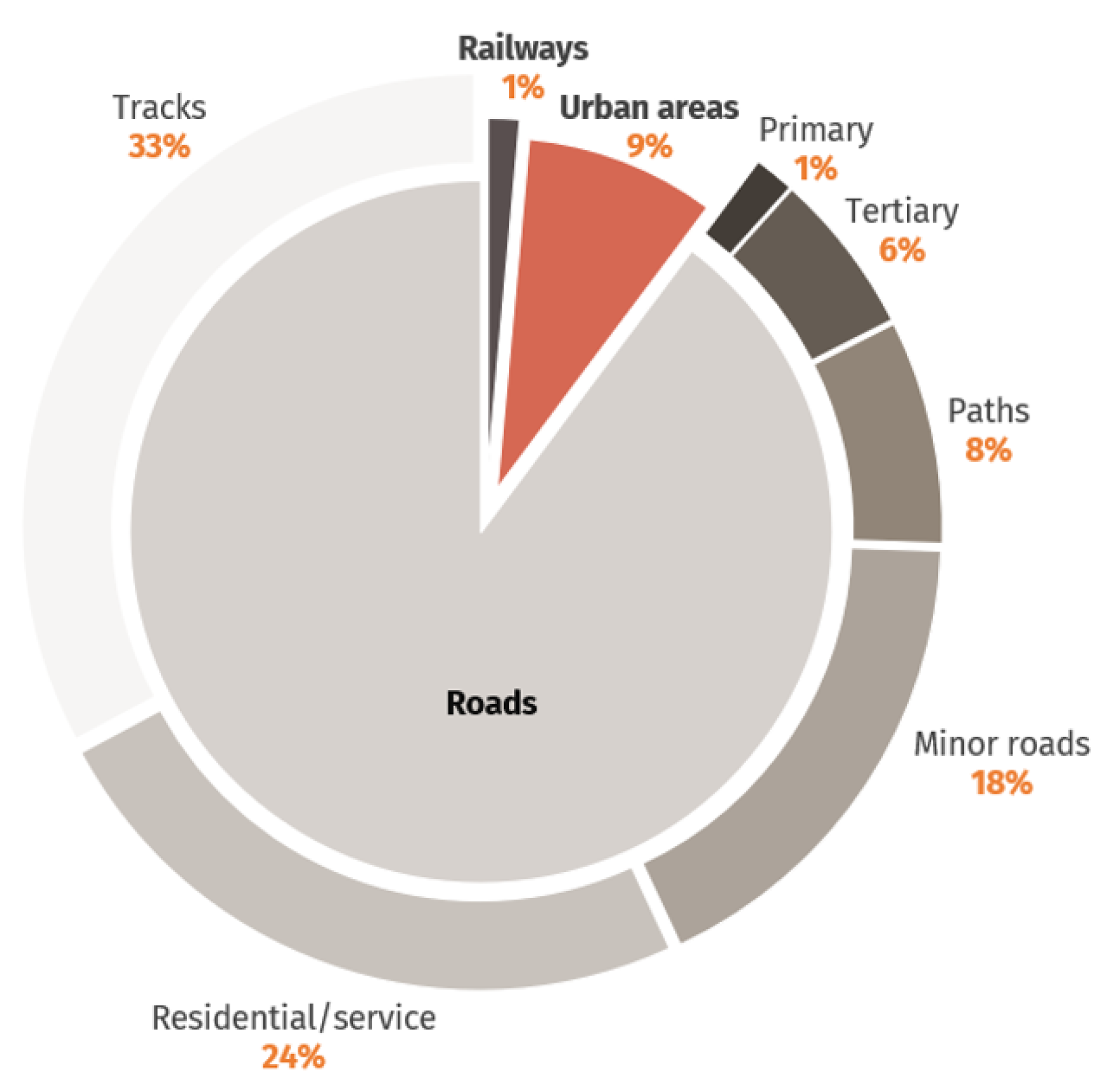
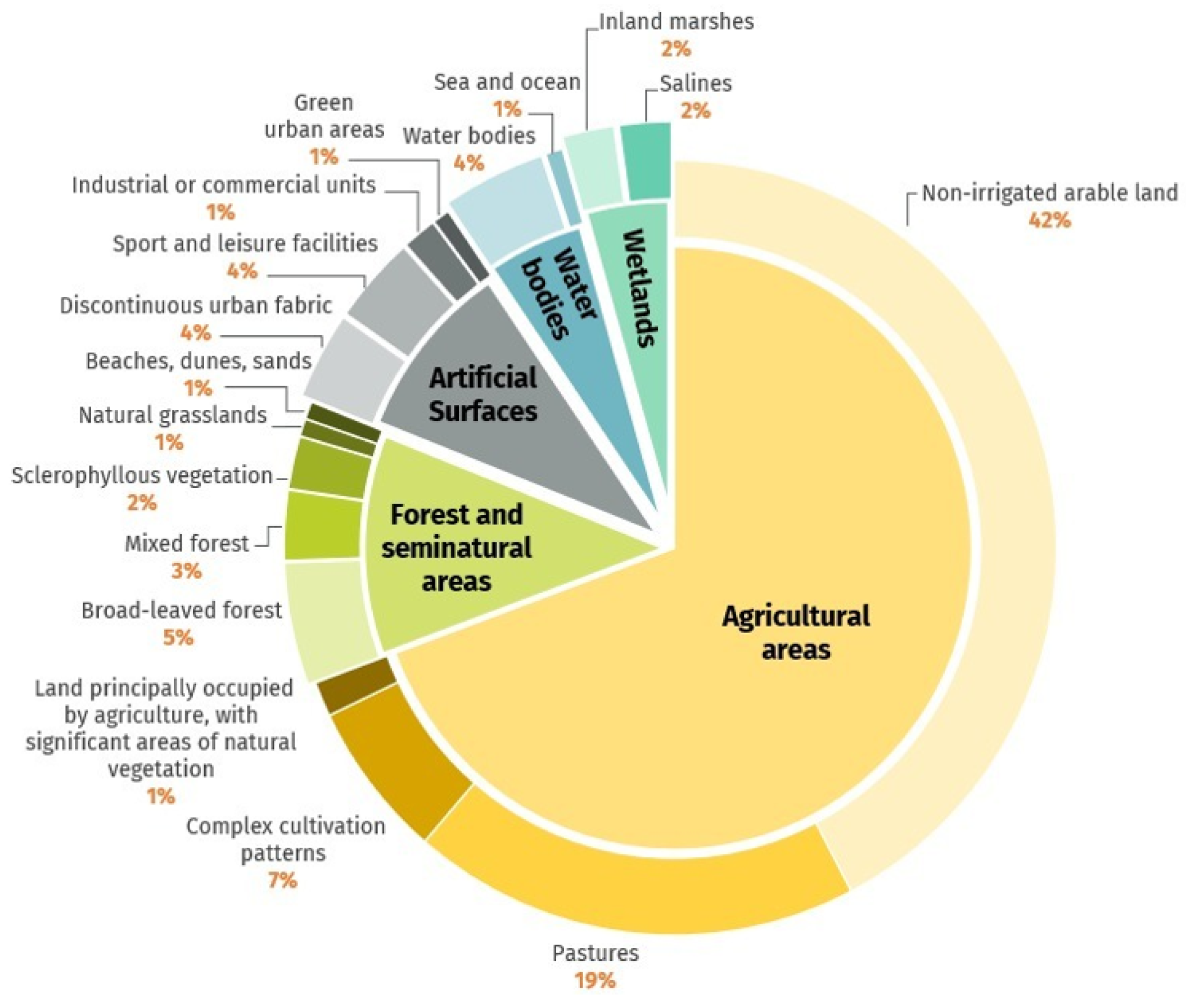

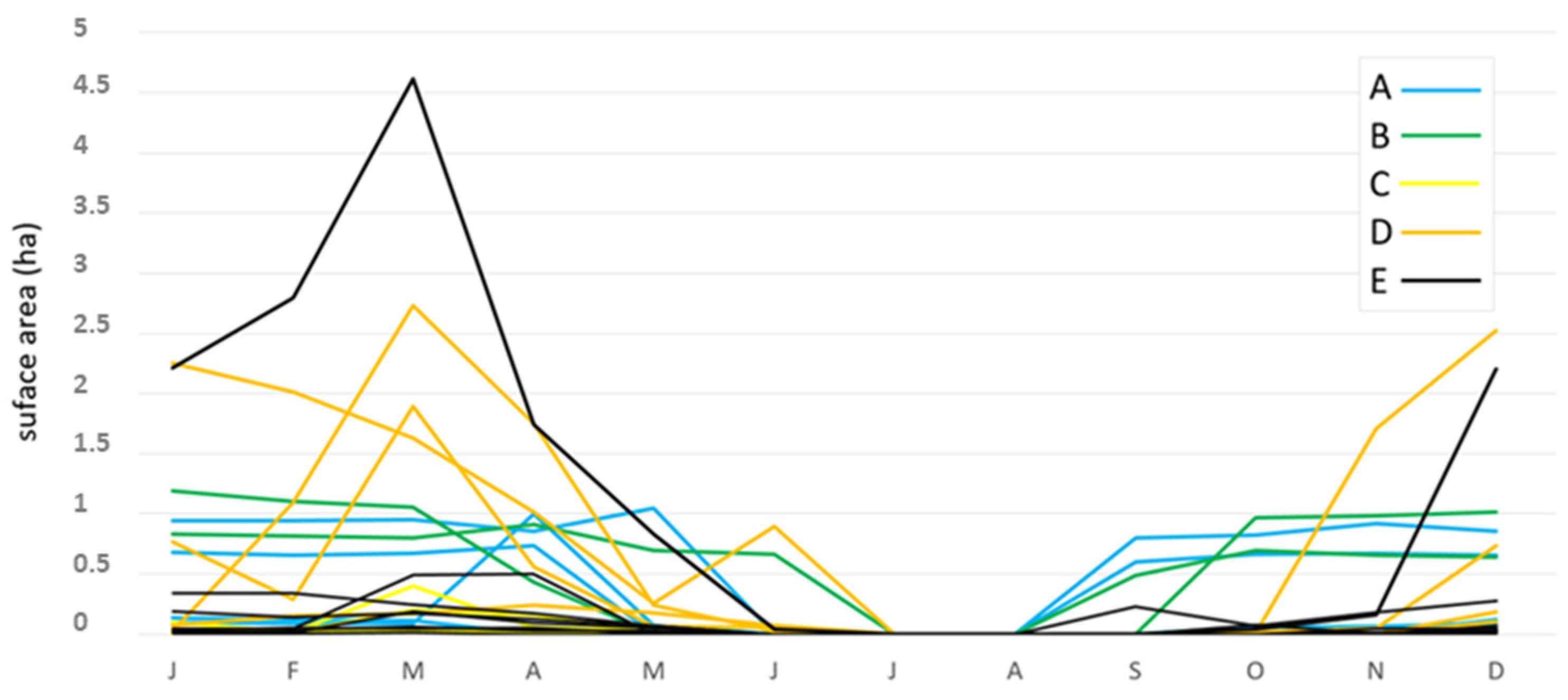

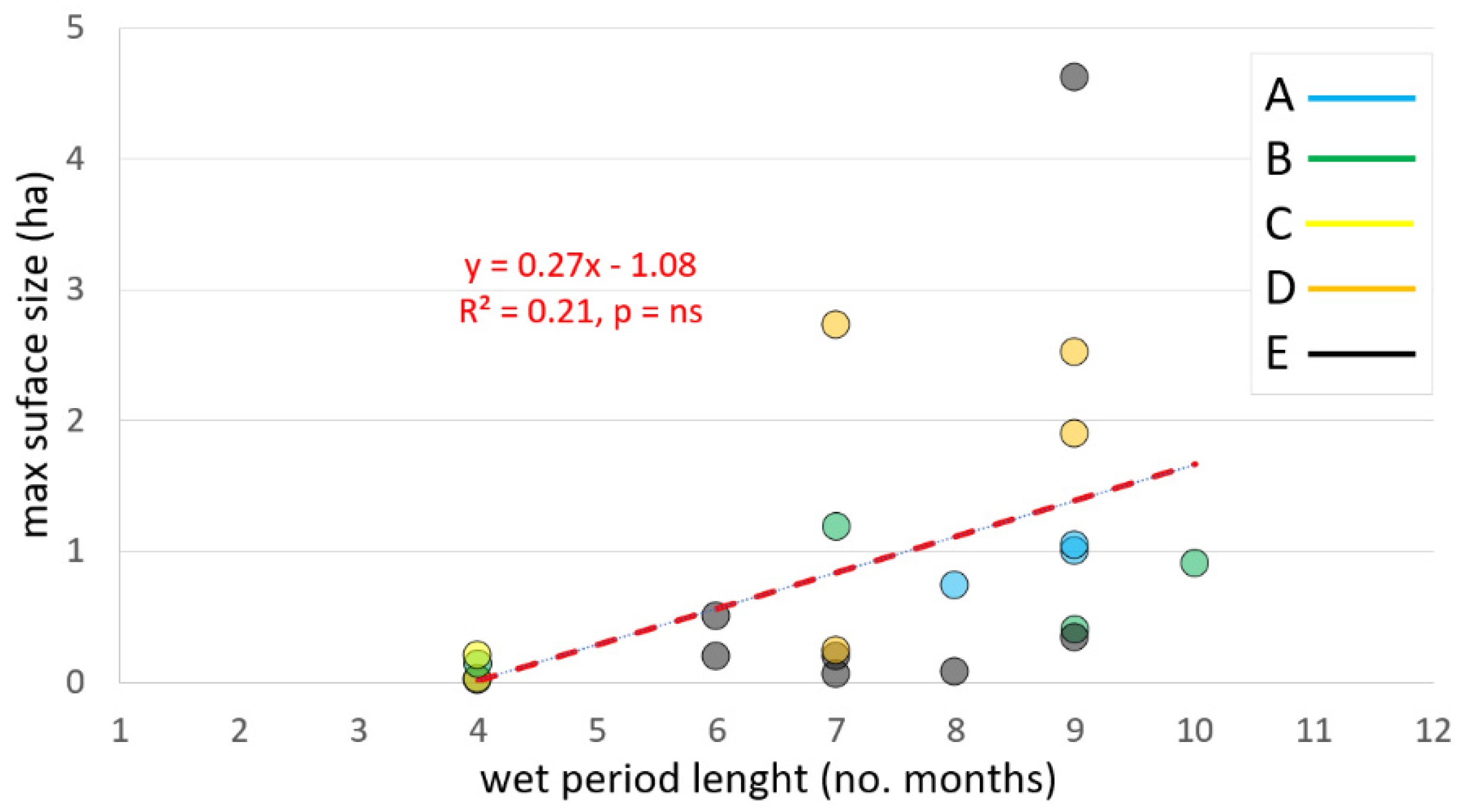
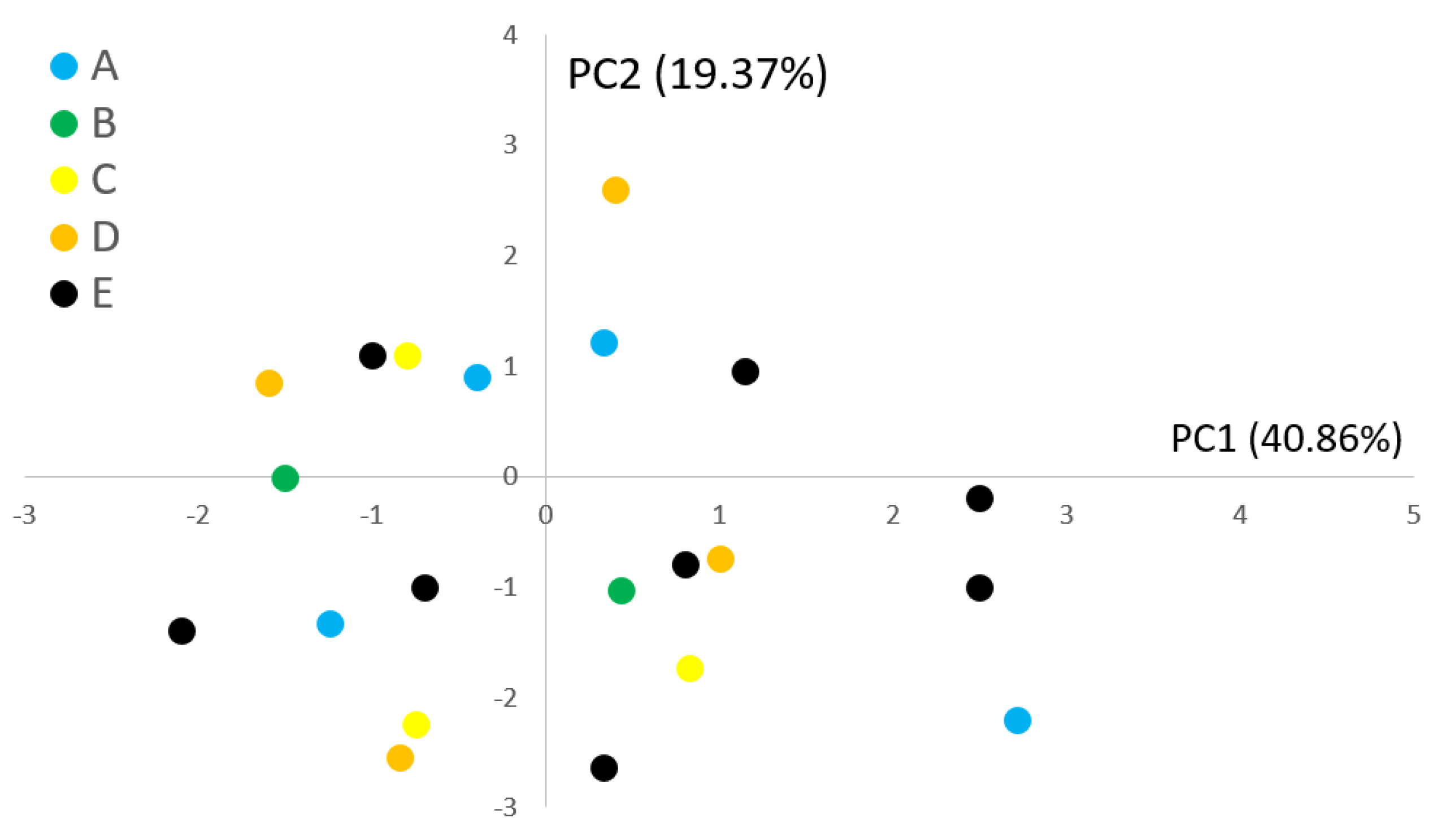
| Group | Site | O2 (mg/L) | O2 (%) | Tatm | Tw | pH | PO43− | NO3− | EC |
|---|---|---|---|---|---|---|---|---|---|
| A | 1 | 2.12 | 3.89 | 15.71 | 13.83 | 8.12 | 1.88 | 4.22 | 1.07 |
| 2 | 2.67 | 3.99 | 16.12 | 13.96 | 8.01 | 1.56 | 3.45 | 1.86 | |
| 3 | 2.80 | 3.19 | 14.87 | 10.02 | 7.74 | 0.59 | 0.39 | 2.63 | |
| 4 | 3.33 | 4.97 | 15.55 | 10.97 | 7.80 | 1.45 | 0.46 | 2.12 | |
| B | 1 | 3.19 | 4.86 | 16.69 | 12.28 | 8.01 | 1.71 | 3.20 | 2.02 |
| 2 | 3.21 | 4.97 | 14.77 | 11.03 | 7.03 | 1.89 | 3.50 | 2.8 | |
| C | 1 | 2.01 | 3.68 | 17.84 | 14.85 | 7.50 | 1.77 | 3.69 | 1.09 |
| 2 | 2.66 | 3.13 | 20.12 | 17.56 | 6.92 | 1.55 | 3.41 | 1.31 | |
| 3 | 1.98 | 2.12 | 19.34 | 16.02 | 7.78 | 1.41 | 4.11 | 2.07 | |
| D | 1 | 3.03 | 4.93 | 14.76 | 11.99 | 7.44 | 1.15 | 2.41 | 1.06 |
| 2 | 3.46 | 4.04 | 16.82 | 14.77 | 7.64 | 0.11 | 0.62 | 1.62 | |
| 3 | 2.03 | 3.83 | 15.07 | 10.29 | 8.04 | 0.24 | 0.53 | 2.02 | |
| 4 | 1.78 | 2.33 | 15.25 | 12.54 | 7.70 | 0.24 | 0.44 | 2.86 | |
| E | 1 | 2.57 | 3.21 | 15.29 | 12.85 | 8.10 | 1.45 | 4.56 | 1.66 |
| 2 | 2.69 | 3.44 | 15.44 | 23.31 | 8.10 | 0.86 | 2.10 | 1.54 | |
| 3 | 2.84 | 3.52 | 15.36 | 11.17 | 7.55 | 0.79 | 1.88 | 1.61 | |
| 4 | 2.22 | 3.59 | 12.41 | 9.14 | 7.35 | 0.27 | 1.88 | 2.49 | |
| 5 | 4.54 | 5.70 | 13.22 | 10.78 | 7.55 | 0.67 | 0.58 | 2.08 | |
| 6 | 2.37 | 3.30 | 12.96 | 10.63 | 7.14 | 0.12 | 0.68 | 1.56 | |
| 7 | 2.66 | 3.30 | 13.44 | 10.96 | 7.82 | 0.14 | 0.75 | 1.87 | |
| 8 | 3.07 | 4.23 | 13.48 | 11.24 | 7.33 | 1.12 | 2.38 | 1.67 |
Publisher’s Note: MDPI stays neutral with regard to jurisdictional claims in published maps and institutional affiliations. |
© 2021 by the authors. Licensee MDPI, Basel, Switzerland. This article is an open access article distributed under the terms and conditions of the Creative Commons Attribution (CC BY) license (https://creativecommons.org/licenses/by/4.0/).
Share and Cite
Scalici, M.; Perrone, M.; Battisti, J.; Benedini, L.; Malavasi, M. First Perceptions of Hydroperiod Mapping and Assessment of Shallow Waters in Coastal Landscapes by Drone-Based Monitoring Activities: A Remote-Sensing and GIS Approach. Appl. Sci. 2021, 11, 9773. https://doi.org/10.3390/app11209773
Scalici M, Perrone M, Battisti J, Benedini L, Malavasi M. First Perceptions of Hydroperiod Mapping and Assessment of Shallow Waters in Coastal Landscapes by Drone-Based Monitoring Activities: A Remote-Sensing and GIS Approach. Applied Sciences. 2021; 11(20):9773. https://doi.org/10.3390/app11209773
Chicago/Turabian StyleScalici, Massimiliano, Michela Perrone, Jacopo Battisti, Livia Benedini, and Marco Malavasi. 2021. "First Perceptions of Hydroperiod Mapping and Assessment of Shallow Waters in Coastal Landscapes by Drone-Based Monitoring Activities: A Remote-Sensing and GIS Approach" Applied Sciences 11, no. 20: 9773. https://doi.org/10.3390/app11209773
APA StyleScalici, M., Perrone, M., Battisti, J., Benedini, L., & Malavasi, M. (2021). First Perceptions of Hydroperiod Mapping and Assessment of Shallow Waters in Coastal Landscapes by Drone-Based Monitoring Activities: A Remote-Sensing and GIS Approach. Applied Sciences, 11(20), 9773. https://doi.org/10.3390/app11209773








